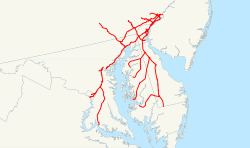Dates of operation 1902–1976 Founded 1902 | Electrification 12 kV 25 Hz | |
 | ||
Track gauge 4 ft 8 ⁄2 in (1,435 mm) standard gauge Length 717 miles / 1,154 km(pre-PCC&StL merger) Predecessors Philadelphia, Wilmington and Balti Railroad | ||
The Philadelphia, Baltimore and Washington Railroad (PB&W) was a railroad that operated in Pennsylvania, Delaware, Maryland, and the District of Columbia in the 20th century, and was a key component of the Pennsylvania Railroad (PRR) system. Its 131-mile (211 km) main line ran from Philadelphia to Washington. The PB&W main line is now part of the Northeast Corridor, owned by Amtrak.
Contents
History
The railroad was formed in 1902 when the Pennsylvania Railroad merged two of its southern subsidiaries, the Philadelphia, Wilmington and Baltimore Railroad and the Baltimore and Potomac Railroad.
In 1907, the PB&W became a co-owner of the new Washington Terminal Company, which operated newly built marble "Transportation Temple of America", Washington Union Station.
In 1916, the PB&W operated 717 miles (1,154 km) of road, including 9 miles (14 km) of trackage rights.
Acquisitions
The PB&W acquired six railroad companies:
Improvements
In 1928, the PRR began to electrify the main line between New York City and Washington, D.C. using overhead lines. Electrification of the PB&W portion was completed in 1935. Amtrak still uses the 25Hz traction power system.
Dissolution
In 1968, the Pennsylvania Railroad and its longtime rival New York Central Railroad merged to form the Penn Central Railroad. The PB&W remained a separate legal entity, although controlled and operated by the new company. The Penn Central declared bankruptcy in 1970 but continued to operate trains until 1976, when the company's railroad assets were sold under the Railroad Revitalization and Regulatory Reform Act. Under the new law, Congress authorized the sale of the PB&W right-of-way between Philadelphia and Washington, and related assets (such as the Washington Terminal Company), to Amtrak. Other PB&W assets, including almost all of the PCC&StL (Pan Handle), were sold to the new Consolidated Rail Corporation (Conrail).
